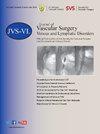Efficacy of ultrasound-guided foam sclerotherapy in the healing of venous leg ulcers
IF 2.8
2区 医学
Q2 PERIPHERAL VASCULAR DISEASE
Journal of vascular surgery. Venous and lymphatic disorders
Pub Date : 2025-04-08
DOI:10.1016/j.jvsv.2025.102244
引用次数: 0
Abstract
Background
Ultrasound-guided foam sclerotherapy (UGFS) for treating the refluxing venous network beneath and in the vicinity of venous leg ulcers (VLUs) has been used widely.
Objective
This trial aimed to assess the efficacy and safety of UGFS for treating VLUs (ISRCTN18090073).
Methods
This study is a multicenter randomized controlled trial. Consenting eligible participants were randomized into two groups: group A received UGFS for the distal refluxing network of veins (eg, ulcer bed venous plexus), in addition to standard care, and group B received standard care alone. Standard care included compression therapy, wound care, ablation of superficial reflux, and recanalization of proximal deep venous obstruction when appropriate. Patients were followed weekly until complete ulcer healing was achieved. All participants will be followed for ≥12 months from the point of randomization to allow calculation of total ulcer-free days during the study period and assess for the recurrence of ulceration from the time of ulcer healing and quality of life measures. The primary outcome was the time to ulcer healing. Secondary outcomes were the rate of ulcer healing, Venous Clinical Severity Score, and patient-reported health-related quality of life.
Results
The study was terminated early for efficacy at the planned interim analysis when one-half the number of patients had completed follow-up. A total of 71 patients, 6 with bilateral VLUs, were recruited. After accounting for dropouts and losses to follow-up, 65 VLUs were available for analysis. Both groups were similar at baseline regarding demographic factors, risk factors, history of deep vein thrombosis, previous venous interventions, and ulcer size. The time to complete ulcer healing was significantly shorter in group A, who received UGFS, as compared with group B, who did not receive UGFS (median, 35 days [interquartile range, 22 days] vs median, 56 days [interquartile range, 58 days]; P = .008). Additionally, more ulcers achieved complete healing within 3 months in group A compared with group B (28/29 [97%] vs 27/36 [75%]; P = .01). Multivariate regression analysis showed a significant effect of UGFS on healing time (P = .004). Group A showed a significantly more rapid reduction in ulcer size (P < .0001). There was a significant improvement in the Venous Clinical Severity Score after treatment in both groups A and B (P < .0001).
Conclusions
Although both groups benefited from standard care for treating VLUs, the addition of UGFS improved treatment outcomes significantly. UGFS accelerated the healing process, resulting in a shorter time to complete ulcer healing and a higher rate of ulcers achieving complete healing within 3 months. These findings suggest that UGFS is a valuable adjunctive treatment for VLUs, enhancing the efficacy of standard care protocols.



超声引导泡沫硬化治疗下肢静脉性溃疡的疗效观察。
背景:超声引导泡沫硬化疗法(UGFS)用于治疗下肢静脉性溃疡(VLUs)下方及附近的回流静脉网络已被广泛应用。目的:本试验旨在评估UGFS治疗vlu的有效性和安全性(ISRCTN18090073)。方法:本研究为多中心随机对照试验。符合条件的参与者被随机分为两组:A组在标准治疗的基础上,对远端静脉回流网络(如溃疡床静脉丛)进行UGFS治疗;B组仅接受标准治疗。标准治疗包括压迫治疗、伤口护理、浅表反流消融术和适当时近端深静脉阻塞再通。患者每周随访一次,直到溃疡完全愈合。从随机分组开始,所有参与者将被随访≥12个月,以便计算研究期间无溃疡天数,并从溃疡愈合时间和生活质量测量中评估溃疡复发情况。主要观察指标为溃疡愈合时间。次要结局是溃疡愈合率、静脉临床严重程度评分和患者报告的健康相关生活质量。结果:在计划的中期分析中,当一半的患者完成随访时,为了疗效,研究被提前终止。共招募71例患者,其中6例为双侧vlu。考虑到退出和随访损失后,65个vlu可用于分析。两组在人口统计学因素、危险因素、深静脉血栓形成史、既往静脉干预和溃疡大小方面的基线相似。与未接受UGFS的B组相比,接受UGFS的A组完成溃疡愈合的时间明显缩短(中位数,35天[四分位数范围,22天]vs中位数,56天[四分位数范围,58天];P = .008)。此外,与B组相比,A组有更多的溃疡在3个月内完全愈合(28/29 [97%]vs 27/36 [75%]);P = 0.01)。多因素回归分析显示,UGFS对愈合时间有显著影响(P = 0.004)。A组溃疡缩小速度明显快于对照组(P < 0.0001)。a组和B组治疗后静脉临床严重程度评分均有显著改善(P < 0.0001)。结论:尽管两组均受益于治疗vlu的标准护理,但UGFS的加入显著改善了治疗结果。UGFS加速了愈合过程,导致溃疡完全愈合的时间更短,溃疡在3个月内完全愈合的比率更高。这些发现表明,UGFS是vlu的一种有价值的辅助治疗方法,可以提高标准治疗方案的疗效。
本文章由计算机程序翻译,如有差异,请以英文原文为准。
求助全文
约1分钟内获得全文
求助全文
来源期刊

Journal of vascular surgery. Venous and lymphatic disorders
SURGERYPERIPHERAL VASCULAR DISEASE&n-PERIPHERAL VASCULAR DISEASE
CiteScore
6.30
自引率
18.80%
发文量
328
审稿时长
71 days
期刊介绍:
Journal of Vascular Surgery: Venous and Lymphatic Disorders is one of a series of specialist journals launched by the Journal of Vascular Surgery. It aims to be the premier international Journal of medical, endovascular and surgical management of venous and lymphatic disorders. It publishes high quality clinical, research, case reports, techniques, and practice manuscripts related to all aspects of venous and lymphatic disorders, including malformations and wound care, with an emphasis on the practicing clinician. The journal seeks to provide novel and timely information to vascular surgeons, interventionalists, phlebologists, wound care specialists, and allied health professionals who treat patients presenting with vascular and lymphatic disorders. As the official publication of The Society for Vascular Surgery and the American Venous Forum, the Journal will publish, after peer review, selected papers presented at the annual meeting of these organizations and affiliated vascular societies, as well as original articles from members and non-members.
 求助内容:
求助内容: 应助结果提醒方式:
应助结果提醒方式:


